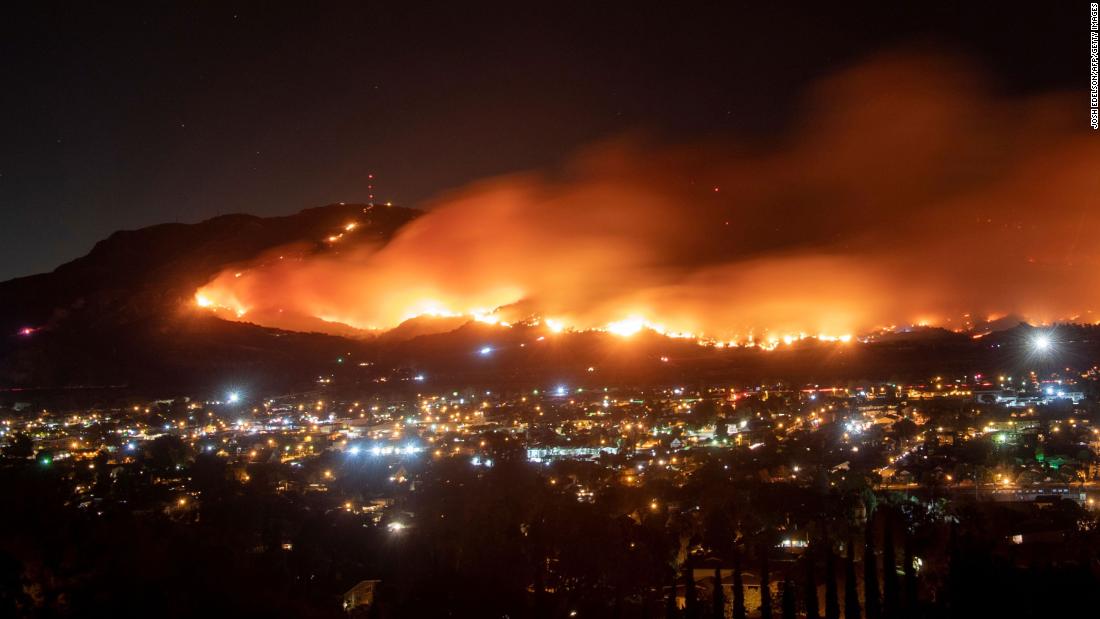
The President blamed Newsom's forest management and state water policies for the frequency and magnitude of the fires. This is not the first time Trump has attacked Newsom and other California politicians for the state's response to fires and other environmental issues. After last year's deadly Camp fire, Trump said the forest floor should have been "raked out" and that then-Gov. Jerry Brown should stop diverting water that could be "used for fires." Trump's comments were roundly criticized as inaccurate at the time.
Here's a breakdown of the President's most recent accusations and the facts behind them.
California forest management
In the first of his series of tweets, the President wrote "The Governor of California, @GavinNewsom, has done a terrible job of forest management. I told him from the first day we met that he must 'clean' his forest floors regardless of what his bosses, the environmentalists, DEMAND of him. Must also do burns and cut fire stoppers...."
Facts First: The recent fires in Southern California did not originate in forests, so blaming bad "forest management" misses the point.
While exact causes have yet to be determined, most of last week's fires occurred in suburban or residential areas. CAL FIRE spokesman Scott McLean told CNN that only one of the blazes which prompted the President's response could be considered a forest fire.
"A lot of our wildland fires are strictly that," McLean said.
Major fires in the state over the past few years have been linked to faulty power lines, some of which belonged to Pacific Gas and Electric. The power company has cut electricity for several areas in hopes of preventing future wildfires.
Scientists and California politicians noted that forest management could not have prevented the fires linked to PG&E equipment or the Woolsey Fire last year, which also did not start in a forest.
The President previously blamed poor forest management for California fires in 2018, shortly before he met then Lt. Gov. Newsom for the first time. Trump has received criticism for casting sole blame on the state's forest management practices, since the federal government manages over half of California's forest land.
Water policy
Trump also appeared to claim that a lack of water was to blame for the spread of California's recent wildfires. He tweeted, "Also, open up the ridiculously closed water lanes coming down from the North. Don't pour it out into the Pacific Ocean. Should be done immediately. California desperately needs water, and you can have it now!"
Facts First: The President is appropriating an age-old fight about water rights for his argument, according to experts who say his claim is "nonsensical" and "absurd." There is also no evidence of any shortage of water available to fight the fires.
About 80% of the water used in California is for farmland. However, many California farmers have voiced complaints that freshwater is being "wasted" on rivers, while environmentalists argue that keeping water in rivers is essential to support salmon and other wildlife.
"What Trump is basically saying is we ought to use every drop of it, primarily for his agricultural friends in the Central Valley," said Peter Gleick, an environmental scientist and former MacArthur Fellow who is president emeritus of the Pacific Institute in Oakland, California.
"If his argument in these tweets is 'Stop diverting water to the Pacific and use it to fight the fires,' it's nonsensical," Gleick told CNN. "He's said this before that somehow he thinks California's water policies are depriving firefighters of water needed to fight the fires. Which is absolutely absurd."
McLean confirmed that CAL FIRE has not experienced a shortage of water available to fight the fires.
"We have absolutely no issues with water," McLean told CNN. "We can pull water out of streams, creeks, lakes, swimming pools. We have the ability to pull it if we need it."
Margaret S. Torn, an ecologist who is a senior scientist at the Lawrence Berkeley National Laboratory, said Trump's claims about water were "a distraction."
"There is no infrastructure to bring water from the delta to the areas that were burning. And those areas are not irrigated, so there's no relationship," Torn told CNN.
"The firefighters themselves had all the water they needed, but that's not the point," Torn added. "I would like to have him attend to the actual difficulties and tragedies that are occurring in the state."
Gleick echoed Torn's concerns the President was focusing on political implications of the fires.
"It's sad to see him using the fires, which are a tragedy for so many people, for his personal political agenda," Gleick told CNN.
Federal funds for fires
As California continues to battle these wildfires, the President has once again threatened to cut federal aid. Trump tweeted, "Every year, as the fire's rage & California burns, it is the same thing-and then he comes to the Federal Government for $$$ help. No more. Get your act together Governor. You don't see close to the level of burn in other states..."
Facts First: FEMA continues to provide aid for those impacted by California fires, though the total amount of federal funds has decreased under Trump.
Newsom's spokesman Jesse Melgar, told the Los Angeles Times, "the reality is that while California has increased fire prevention investments and fuel management projects, the federal government has slashed its funding of those same activities."
There is data that supports Melgar's claim. After the 2018 Camp Fire, the deadliest in California history, FEMA provided over $186 million to date through public assistance grants and the individual & households program. Comparatively, after the 2017 Tubbs fire, previously the most destructive in California history, FEMA aid exceeded $376 million.
Bagikan Berita Ini














0 Response to "Fact-checking Trump's California wildfire criticism"
Post a Comment